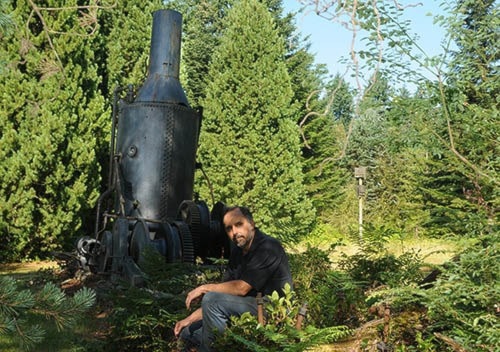Upon a grassy knoll, surrounded by exotic oaks and sycamores, Empire No. 206 stands silent sentinel over the Malcolm Knapp UBC Research Forest.
Its skids are rotten, its cables frayed, and its gears have long since seized.
A hundred years ago, this “steam donkey,” and hundreds other like it, were the beasts of burden the B.C. forest industry was built upon. Twenty-ton monsters that pulled themselves up mountainsides, belching smoke, and breathing fire.
Today, it slowly rusts.
Paul Lawson is hoping to change that.
Lawson is the manager of the UBC research forest, and is spearheading a campaign to help restore the portable steam engine to its former glory and put a roof over it’s head.
While the province of British Columbia was built on the back of the forestry industry, the steam donkey is what made industrial scale logging on the remote, steep mountainsides possible.
“It was the backbone,” says Lawson.
For more than 50 years, the steam donkey was essential part to any logging camp, until they were made obsolete by diesel engines and logging trucks in 1940s. Essentially a steam-powered winch, it was primarily used to run a cable “yarder” suspended from a pole to haul logs onto trains or into nearby bodies of water for transport.
“It was basically like a big clothesline,” says Lawson. “What’s interesting is that we’re basically using the same technology today. We use internal combustion engines with a fancier transmission, but the method and the rigging systems… are essentially the same.”
Despite standing more than 15 feet high and weighing 20 tons, the steam donkeys were essentially self propelled on their canoe-sized wooden skids.
“Once they were loaded with wood and water, they could drag themselves around the bush on their skids by grabbing a stump and just pulling themselves,” says Lawson. “They could go anywhere and do anything.”
They were fed a diet of three to seven cords of wood daily, by a crew of up to 20 men. Covered in soot and dirt, it was their job to chop and feed the hungry steam engine.
“I cut three cords of wood a year to heat my house,” says Lawson. “Those were some hard working guys.”
Belching hot smoke and embers, the threat of forest fires was ever present while working with a steam donkey. Countless forest fires were sparked by steam donkeys in the hot summer months.
Empire No. 206 was built in Vancouver one hundred years ago in 1912, according to markings on it’s cast iron boiler. The massive steam engine likely worked throughout what is now Golden Ears Provincial Park, back when the Abernethy and Lougheed Logging Company was in its heyday in the 1920s.
The logging company laid 55 miles of railroad into the forested valleys north of Maple Ridge, where crews harvested more than 2,800 hectares of old growth cedar and fir.
However, in 1931, logging in the area came to a halt when the forest burned, uncontrolled for more than a month. A spark from logging equipment in the area started the fire, and destroyed what is now the southern portion of Golden Ears Provincial Park.
The logging operation was abandoned, as was Empire No. 206 on the western flank of Golden Ears.
There it sat rusting in the woods until the spring of 1974, when it was discovered by a group of students, and given new life.
Dick Cain was a student in UBC’s forestry program in the 1970s, and was in the woods the day his classmates found Empire No. 206.
“Every spring we set up a camp in the area… and some classmates of mine were timber cruising when they came upon it,” he remembers. “It was a long ways from the lake. It’s amazing they got it up there.”
Every year, the graduating class in the forestry program would work on a single project together, so the Class of ‘75, with Cain as one of their leaders, decided to bring the steam donkey back to civilization and restore it.
They quickly realized it was too large and too remote to be moved by truck.
Empire No. 206 was cut into four pieces to make it easier to transport, and after some fundraising, Cain and his classmates were able to enlist the help of a helicopter company in the Okanagan to fly the pieces out for a reduced rate.
“They were the only ones in the province with a Sikorsky helicopter big enough to do the job,” says Cain. “Without them, we wouldn’t have got it out of there.”
They flew the pieces to entrance of Malcolm Knapp UBC Research Forest, and reassembled the pieces atop a pair of skids sourced from another steam donkey.
After some sandblasting and a fresh coat of paint, Empire No. 206 looked very much like it would have when it was built back in 1912.
“All the brass dials and fittings were gone, but it didn’t have to be operational,” says Cain. “For a bunch of kids, it was a pretty big accomplishment.”
But after more than 35 years of welcoming students and visitors to the UBC research forest, Empire No. 206 is need of a makeover, and a new home.
“Anyone with any carpentry know-how would be a big help,” says Lawson.
The moss and mildew has already been power washed off, revealing markings and stamps long obscured by time. The Hammond Cedar Mill has donated a pair of logs for new skids, but they will need to cut and planed.
And there’s still the matter of a roof to protect Empire No. 206 from the elements.
“This is a piece of history, and we want make sure that it will be around 100 years from now,” says Lawson.
• If you would like to help with the restoration of Empire No. 206, contact Paul Lawson at 604-463-8148, or paul.lawson@ubc.ca
